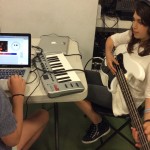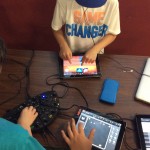I’ve recently been thinking a lot about Tom Little’s new book Loving Learning: How Progressive Education Can Save America’s Schools. In it he highlights a number of progressive school values that prepare students for success.
“If we truly want to encourage our kids to be critical thinkers, problem solvers, and collaborators, we have to give them opportunities to practice those skills early on.” -Tom Little
The role of technology in the music classroom helps provide this kind of experience for our students like never before. One such activity I conducted with my 5th graders this past spring was a small group original song and performance project. Working in groups of 4 or 5 students needed to create and perform an original work that had an A and B section each with an original chord progression and melody. In addition to performing the chord progression and melody every song needed to have a bass line played on either an electric bass or an iPad as well as a percussion part that could be played or programmed. This project gave students the freedom to combine some very new music education technology along with their traditional band instruments, pianos, guitars or their voice.
Getting Started with AQWERTYON
My students had already composed two large scale compositions in which we explored a multitude of concepts one being chord progressions. Regardless, we still began with a preliminary activity in which students practiced playing the chord progression to the Beatle’s “Let It Be” using the web instrument AQWERTYON. Designed by Alex Ruthmann and his MusEdLab team at NYU this tool transforms any computer keyboard into a musical instrument! It makes it very easy for students to play diatonic chords and melodies. Best of all everyone of my students can use this tool at home to practice and come to class prepared to share whatever it is they’ve been working on. A helpful tool we used for playing along to chord progressions was Hooktheory’s Theory Tab. Students could see the progression for “Let It Be” and also play along to it.
Performing Original Chord Progressions
Students then used AQWERTYON to create their original chord progressions. As one or two students played the chord progression on AQWERTYON other group members could begin to learn how to play it on more traditional instruments like piano or guitar. What I love about this is that it allows those students who do not play chordal instruments to be in on the creation and performance of the progression. Some students chose to perform the chord progression on an iPad-Garageband smart instrument. One group member was responsible for learning the corresponding bass notes to go along with the chords. Each group also had to work out who would perform the percussion part and the melody. Some groups chose a singer for the melody while others reached for their band instrument.
Class Time Rehearsals
Over a span of 6 to 8 periods students spent class time creating and rehearsing their original song. The music room felt like a workshop as each group independently set about their work. Having each group set up with a Jamhub allowed me to float around the room and give individual attention to groups as they needed it. I could simply plug my headphones into the Jamhub and listen in to get a sense of how things were going. As with any progressively designed activity it mattered not if each group was in a different point in their progress. Groups had ample time to work through at their own pace any problems they were having or had freedom to spend time exploring creative ideas as they arose. We ended each class period with a brief share from every group. I reminded students that their song didn’t need to be completed, it was just important that they perform something they had worked on that class. I could quickly plug a small speaker into each group’s Jamhub for the entire class to hear. These brief performances served to motivate and inform everyone. I would even play the recordings from one 5th grade class split for another split so all could benefit from each group’s efforts.
Recording Day!
We concluded the project with a final class recording session! Each group was well rehearsed and able to perform a multitrack recording of their original song. I was able to project the DAW (I used Logic) for the entire class to see which allowed for some discussion of how each group was executing their performance. A discussion of the possibilities afforded by multitrack recording came up which led to some groups overdubbing extra parts. See below for the final recordings mixed with the video of the recording session.






Matt, thanks for posting. In addition to creating the opportunities as Little suggest to practice these skills, there is also something important here about the nature of the curriculum itself. In your example, the curriculum is not simply content to be covered, but a scaffolding for exploration and discovery. Further, the assessment is self-evident and embedded in the work (i.e., the group creates an original composition that meets a set of criteria). In addition, because the criteria are clear, you can best determine what level of support each group needs to either meet or exceed the expectations. Most importantly, the kids are engaged in purposeful work that is personally relevant.